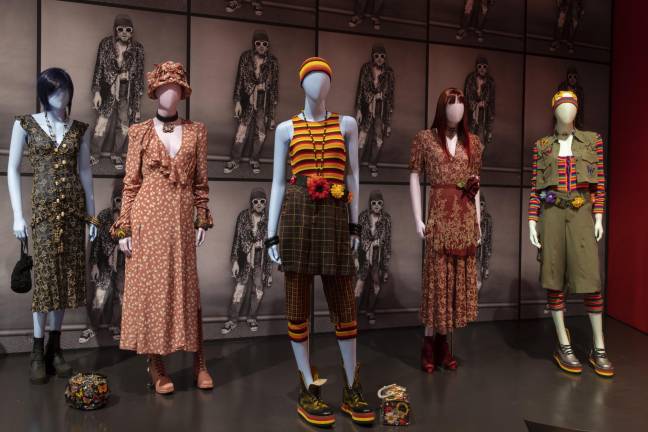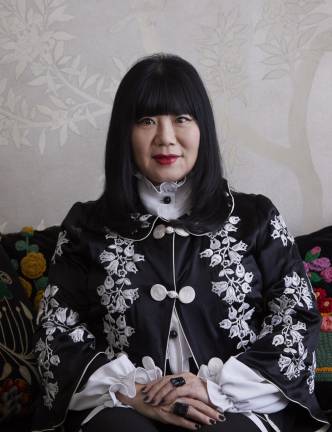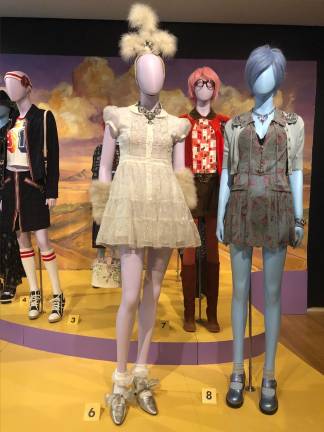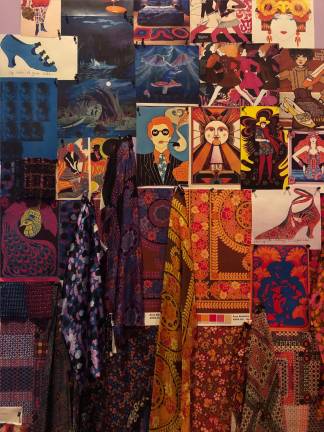Bohemian Rhapsody
Fashion designer Anna Sui's kaleidoscopic vision is lighting up fall in Manhattan




Anna Sui is having a New York moment. The fashion queen’s designs are the stuff of a splashy retrospective at the Museum of Arts and Design (MAD) on Columbus Circle at the same time that they are premiering in Edwaard Liang’s new piece, “Lineage,” for the New York City Ballet at Lincoln Center.
Known for her eclecticism and devotion to the color purple, Sui, at 67 (roughly), has the city at her feet. And that’s the way it should be after decades of ready-to-wear styles launched from the heart of the Garment District, which she helped preserve as a pocket of innovation and manufacturing with her early support of the Save the Garment District movement.
The child of Chinese immigrants, Sui came to the city by way of suburban Detroit, where she grew up reading Vogue and Seventeen, admiring the style of First Lady Jackie Kennedy and going downtown to rock concerts with her brother. After attending her aunt and uncle’s wedding in New York, she decided to become a fashion designer.
She moved to the city in the 1970s and enrolled in Parsons School of Design, where she learned about an opportunity to work for a clothing label and, at 21, left school behind to pursue her dream. She launched her business in 1981 and had her first runway show ten years later.
"The Unfamiliar Perspective on Familiar Things"
The fun begins in the lobby of MAD with a trompe-l’oeil in deep purple of the façade of Sui’s first shop in SoHo on Greene Street, and continues into the elevators, which are awash with the symbols of her brand—mannequin “dolly heads,” butterflies and Tiffany lamps.
The doors open onto a series of environments that the organizers have created on two floors to conjure the designer’s catwalk shows, her boutiques (over 50 stores in eight countries) and her midtown studio. It’s a kaleidoscopic, multi-sensory experience, with music, video and even fragrance from “Fantasia,” one of her perfumes, in the air.
The all-out, brilliantly colored ensembles are arranged according to 12 “archetypes.” These are the themes that have inspired Sui’s fashion collections, interiors, licensed products and accessories. Think Mod, Androgyny, Retro, Surfer, Americana, Schoolgirl, Punk, Hippie & Rockstar, Grunge, Victorian, Fairytale and Nomad, the latter a nod to the many cross-cultural references in her clothing.
As she once said, “I’m always looking for the unfamiliar perspective on familiar things. That takes research, which is my favorite thing.” One of the most revealing parts of this exhibit is the display of her studio’s “mood boards” for the Fall 2019 “Poptimistic” collection—that place where she hashes out ideas and we see the products of her research, the things in the culture and in history that move her, like art, interior design, fashion, film, youth and rock ‘n’ roll.
Busby Berkeley and Kurt Cobain
Fabric swatches, sequins, trims, a copy of Warhol’s silkscreen Marilyn, color charts, print samples, psychedelic illustrations, and more adorn the boards. Her interests are “all-encompassing,” according to the wall text – there is no limit.
And we see it in the layered looks, which borrow from sources as diverse as Busby Berkeley musicals, beach movies, Aubrey Beardsley, the Rolling Stones and Kurt Cobain. Sui is known especially for her custom prints, many of which she creates herself. But she has also relied on the talents of Zandra Rhodes and Barbara Hulanicki for textile designs.
The process of building her collections and mounting her shows is immensely collaborative. She has long-standing relationships with a whole host of designers and creative outfits, including: Erickson Beamon for jewelry; Ballin for leather boots and handbags; Garren (“The Godfather of Hair”) for hairstyling; Pat McGrath and Francois Nars for make-up; Steve Meisel for photography; Mondottica for eyewear; and James Coviello for hats, knitwear and props, like the iridescent palm trees that frame the Retro and Surfer collections. Coviello also designed those funky knit handbags shaped like houses in the Fairytale section—and “Owl Cap with Tassels” (Fall 2012) and “Frog Hat” (Fall 1998).
Narratives Real and Imagined
The keyword here is storytelling. Sui weaves narratives that are both real and imagined, featuring schoolgirls in baby-doll dresses and anklets and fantasy figures in pirate and animal hats. Inspired by Seattle’s punk-rock scene in the early 1990s, she is famous for embracing grunge, first brought to the luxury market by Marc Jacobs. Kurt Cobain’s image is the backdrop for these looks, which she has deemed more “felt” than “thought.”
“I think that, with hindsight, this may have been a moment in my career where my own past and present truly came together,” she has said about the style that made ripped jeans, baggy shirts and thrift-store items cool. It’s a shaggy-dog aesthetic, though in Sui’s universe, grunge is given a more positive spin. It’s prettified and combined with hippie staples. Her “Rainbow Grunge Ensemble” and “Rainbow Kilt Ensemble” (Spring 1993) pair grunge favorites, like a kilt and Army fatigues, with floral belts and multi-colored tops inspired by the Beatles’ Sgt. Pepper album cover from 1967.
It’s all part of her signature style, a mash-up of the archetypes that bridges opposing forces—light and dark, playful and serious, feminine and masculine, flowers and fatigues—and defines the world of Anna Sui.
IF YOU GO
What: The World of Anna Sui
Where: The Museum of Arts and Design (MAD), 2 Columbus Circle
When: Through February 23